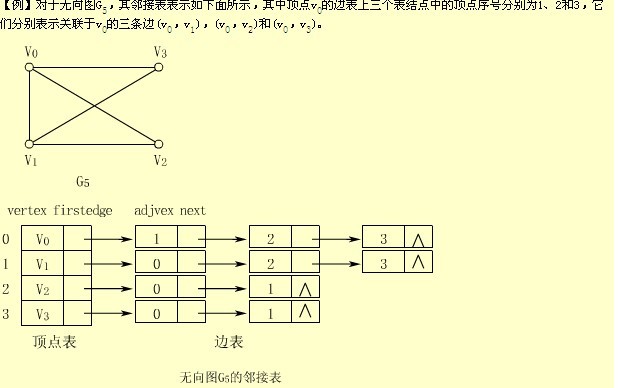图的邻接表存储c实现
2014-09-17 17:11
387 查看

用到的数据结构是
一个是顶点表,包括顶点和指向下一个邻接点的指针
一个是边表, 数据结构跟顶点不同,存储的是顶点的序号,和指向下一个的指针
刚开始的时候把顶点表初始化,指针指向null。然后边表插入进来,是插入到前一个,也就是直接插入到firstedge指向的下一个,而后面的后移
[cpp]
view plaincopyprint?
#define MaxVertexNum 100
typedef char VertexType;
typedef struct node //边表节点
{
int adjvex;
node* next;
}EdgeNode;
typedef struct //顶点表节点
{
VertexType vertex;
EdgeNode* firstedge;
}VertexNode;
typedef VertexNode AdjList[MaxVertexNum];
typedef struct
{
AdjList adjlist;
int n,e;
}ALGraph;
以下建立的是无向图的邻接表,有向图的更简单了
[cpp]
view plaincopyprint?
#include <stdio.h>
#include <stdlib.h>
#define MaxVertexNum 100
typedef char VertexType;
typedef struct node //边表节点
{
int adjvex;
node* next;
}EdgeNode;
typedef struct //顶点表节点
{
VertexType vertex;
EdgeNode* firstedge;
}VertexNode;
typedef VertexNode AdjList[MaxVertexNum];
typedef struct
{
AdjList adjlist;
int n,e;
}ALGraph;
void create(ALGraph*);
void main()
{
ALGraph* G= (ALGraph*)malloc(sizeof(ALGraph));
create(G);
for (int i=0;i< G->n;i++)
{
printf("%d->",i);
while(G->adjlist[i].firstedge!=NULL)
{
printf("%d->",G->adjlist[i].firstedge->adjvex);
G->adjlist[i].firstedge=G->adjlist[i].firstedge->next;
}
printf("\n");
}
}
void create(ALGraph* G)
{
int i,j,k,w,v;
EdgeNode *s;
printf("读入顶点数和边数");
scanf("%d,%d",&G->n,&G->e);
for (i=0;i<G->n;i++)
{
fflush(stdin);
printf("建立顶点表");
G->adjlist[i].vertex=getchar();
G->adjlist[i].firstedge=NULL;
}
printf("建立边表\n");
for (k=0;k<G->e;k++)
{
printf("读入(vi-vj)的顶点对序号");
scanf("%d,%d",&i,&j);
s=(EdgeNode*)malloc(sizeof(EdgeNode));
s->adjvex=j;
s->next=G->adjlist[i].firstedge; //插入表头
G->adjlist[i].firstedge=s;
s=(EdgeNode*)malloc(sizeof(EdgeNode));
s->adjvex=i;
s->next=G->adjlist[j].firstedge;
G->adjlist[j].firstedge=s;
}
}
结果

自己也编程试试吧!
接下来图的遍历,深度优先遍历和广度优先遍历。
相关文章推荐
- 图的邻接表存储(C语言实现)
- 带权图(网)的邻接表存储的C++实现
- 图的存储之邻接表--C语言 链表实现
- 第六章:图。(邻接表实现图的存储及dfs、bfs)
- 算法与数据结构基础8:C++实现有向图——邻接表存储
- 以邻接表为存储结构的---图的算法实现
- 数据结构:图(邻接表存储 c++实现)
- 图的邻接表存储 c实现
- 图的邻接表存储 c实现
- <C/C++图>图的邻接表存储(C++模板实现)
- 图的邻接表存储 深度优先遍历 广度优先遍历 C语言实现
- 求有向图的强连通分支(邻接表存储)C++实现
- 无向图的深度优先搜索(采用邻接表存储)C++实现
- STL 实现邻接表的存储与深搜广搜的完美结合不容错过啊!!!
- prim算法构造最小生成树(邻接表和数组两种存储方式实现)
- 图的邻接表存储 深度优先遍历 广度优先遍历 C语言实现
- 无向图的广度优先搜索(采用邻接表存储)C++实现
- 利用邻接表存储图,实现其递归与非递归的深度遍历和广度遍历
- 图的邻接表存储 c实现
- C++实现图的邻接表存储和广度优先遍历实例分析
